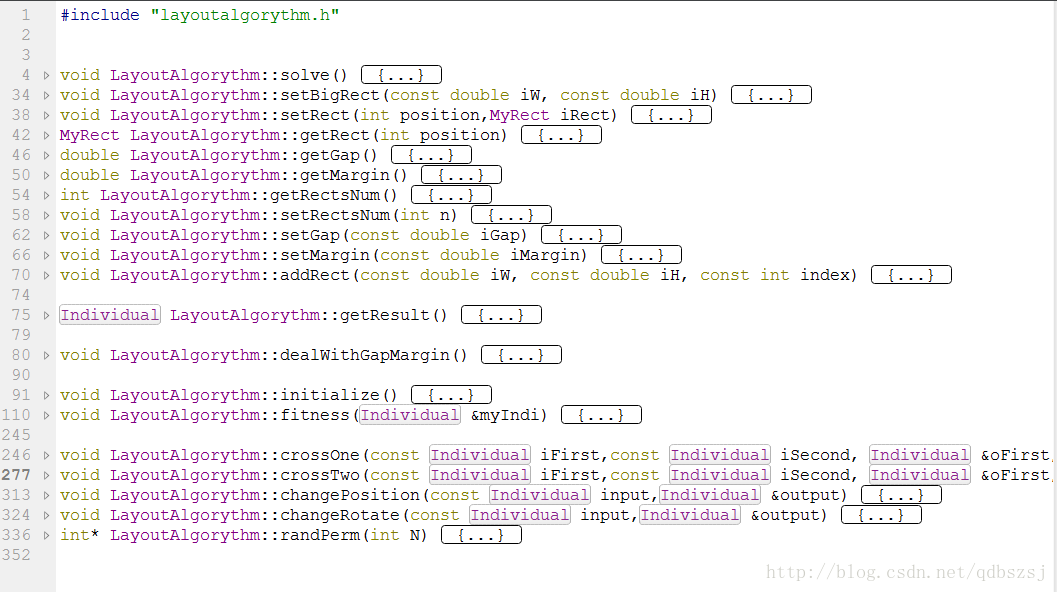矩形排样问题 遗传算法解决方案
最近在实习中,遇到了一个实际问题。客户要将若干大小不一的小矩形,排到大矩形上,而且还要求可以设置小矩形之间的间距,和大矩形的margin值,便于裁切。
排样问题是一个经典的NP问题,有很多解决方案。神经网络、遗传、蚁群、模拟退火等等算法都可以解决这个问题。对于一些行业的工业生产,很多生产数据并没有测试数据那般刁钻,所以这些算法基本都能满足生产的需要。
在这里,我主要参考了一篇郑州大学的研究生毕业论文,自己又稍加了修改,用遗传算法解决了这个问题。
遗传算法的本质其实就是把问题简化为一个个序列,根据一定规律随机生成后,拿这个编码序列贪心的得出解,然后不断的迭代,优胜劣汰,向最优解靠拢。
我认为遗传算法有几个关键之处:编码规则、初始种群的选取、贪心方式、适应度函数的选择、变异规则。
1.好的编码规则能便于程序的实现,同时也决定了程序的贪心结构,在这里,我的编码是1-n的阿拉伯数字,代表放入的矩形的编号,从左到右是放入的顺序。如果矩形需要旋转,则为负数。
2.初始种群的选取,给矩形按照权值排序,权值=0.9*矩形面积+0.1*矩形长宽比,大的先放,小的后放,然后随机其正负值,生成初始种群,好的初始种群能很快就找到最优解。
3.我的贪心解决方案就是最低水平线算法,从左到右,从下到上,不断的寻找能放入的点。每次放入一个新点后,把未来的矩形可能的存在的点加入一个有序的序列中,后面的待排矩形就在这个序列里寻找可以放的点。
4.适应度函数,两个个体好坏的决定因素,在这里,我设置了3个决定因素,首先是放入的矩形面积占待放入的矩形面积的百分比,第二个是当前排入的矩形的最大高度,第三个是排入矩形的整齐程度(高的种类个数)。我还有一些新想法,比如比较新图形的重心,重心越靠左下约好,能避免一些相同适应值下的非最优解。
5.变异规则,这里用了4种变异方案,交叉、单点。。。。。。不详述了。
这里我把算法封装到了类里
#ifndef LAYOUTALGORYTHM_H
#define LAYOUTALGORYTHM_H
#include <iostream>
#include <stdio.h>
#include <math.h>
#include <stdlib.h>
#include <string>
#include <string.h>
#include <algorithm>
#include <vector>
#include <queue>
#include <set>
#include <map>
#include <stack>
#include <QDebug>
using namespace std;
#include "layoutalgorythmglobal.h"
class LayoutAlgorythm;
struct MyPoint{
double x,y;
MyPoint(){}
MyPoint(double ix,double iy){
x=ix;
y=iy;
}
friend bool operator<(const MyPoint&a ,const MyPoint &b){
//按照y值排序,y相等时按照x排
if(a.y==b.y)return a.x<b.x;
else return a.y<b.y;
}
};
struct MyRect{
double width,height,S;
double ratio;
int index;
MyRect(){}
MyRect(double iWidth,double iHeight,int iIndex){
width=iWidth;
height=iHeight;
S=iWidth*iHeight;
ratio=max(height/width,width/height);
index=iIndex;
}
MyRect(double iWidth,double iHeight){
width=iWidth;
height=iHeight;
S=iWidth*iHeight;
ratio=max(height/width,width/height);
}
friend bool operator<(const MyRect &iRectA , const MyRect &iRectB){
double PriorityA=LayoutAlgorythmGlobal::m_weightArea*iRectA.S+LayoutAlgorythmGlobal::m_weightRatio*iRectA.ratio;
double PriorityB=LayoutAlgorythmGlobal::m_weightArea*iRectB.S+LayoutAlgorythmGlobal::m_weightRatio*iRectB.ratio;
return PriorityA>PriorityB;
//大的靠前
//Priority=WeightArea*R[i].S+WeightRatio*R[i].(L/W)
}
};
struct Individual
{
int m_order[100];//顺序,有正负,没有0
MyPoint m_position[100];//每个矩形的左下角位置
double m_val[3];//插入的面积,最高的水平线,获得的高度种类个数
Individual(){}
friend bool operator<(const Individual&iIndiA ,const Individual &iIndiB){
if(iIndiA.m_val[0]==iIndiB.m_val[0]){
if(iIndiA.m_val[1]==iIndiB.m_val[1]){
return iIndiA.m_val[2]<iIndiB.m_val[2];//高度种类越小越好
}
else return iIndiA.m_val[1]<iIndiB.m_val[1];//最高水平线越小越好
}
else{
return iIndiA.m_val[0]>iIndiB.m_val[0];//插入的面积越大越好
}
}
};
class LayoutAlgorythm
{
public:
void setBigRect(const double iW,const double iH);
void setGap(const double iGap);
double getGap();
void setMargin(const double iMargin);
double getMargin();
void addRect(const double iW,const double iH,const int index);
void setRect(int position,MyRect iRect);
MyRect getRect(int position);
void dealWithGapMargin();
void solve();
void setRectsNum(int n);
int getRectsNum();
Individual getResult();
LayoutAlgorythm(){}
private:
//最低水平线算法,by Shijing
double m_totalS=0;
int m_num=0;//num_of_small_rect
Individual m_population[120];
MyRect m_rects[100];//第0个是container
double m_gap=0;//矩形之间的间距
double m_margin=0;//与边框的间距
void initialize();//生成初始种群按照排序规则初始化后存到population里,并更新fitness值
int* randPerm(int N);//生成N个不同的1-N的随机数
void fitness(Individual &myIndi);
void crossOne(const Individual iFirst,const Individual iSecond, Individual &oFirst, Individual &oSecond);//单点交叉
void crossTwo(const Individual iFirst,const Individual iSecond, Individual &oFirst, Individual &oSecond);//双点交叉
void changePosition(const Individual input,Individual &output);//位置变异
void changeRotate(const Individual input,Individual &output);//旋转变异
};
struct randnum
{
int index;
int v;
friend bool operator<(const randnum&a,const randnum&b){
return a.v<b.v;
}
};
#endif // LayoutAlgorythm_H
啊
#ifndef LAYOUTALGORYTHMGLOBAL_H
#define LAYOUTALGORYTHMGLOBAL_H
class LayoutAlgorythmGlobal
{
public:
static double m_weightArea;//矩形排序,面积权重
static double m_weightRatio;//矩形排序,长宽比权重
const static int m_members;//种群规模
const static int m_maxSize;//小矩形个数
static int m_iterCount;//最大迭代次数
static double m_pc1;//单点交叉概率
static double m_pc2;//两点交叉概率
static double m_pm1;//两点交换变异概率
static double m_pm2;//单点旋转变异概率
LayoutAlgorythmGlobal();
};
#endif // LAYOUTALGORYTHMGLOBAL_H
后面,就是实现这些东西了

这里的solve,相当于主函数了,排序后留下的第一个,就是最优解了:
void LayoutAlgorythm::solve()
{
//随机将前M个两两配对,产生后M个新个体,再排序,迭代50次
this->initialize();
int members=LayoutAlgorythmGlobal::m_members;
double Pc1=LayoutAlgorythmGlobal::m_pc1;
double Pc2=LayoutAlgorythmGlobal::m_pc2;
double Pm1=LayoutAlgorythmGlobal::m_pm1;
double Pm2=LayoutAlgorythmGlobal::m_pm2;
for(int i=0;i<LayoutAlgorythmGlobal::m_iterCount;i++){
int operationP=members;
for(int j=0;j<(int)(Pc1*members);j+=2){
crossOne(m_population[rand()%members],m_population[rand()%members],m_population[operationP],m_population[operationP+1]);
operationP+=2;
}
for(int j=0;j<(int)(Pc2*members);j+=2){
crossTwo(m_population[rand()%members],m_population[rand()%members],m_population[operationP],m_population[operationP+1]);
operationP+=2;
}
for(int j=0;j<(int)(Pm1*members);j++){
changePosition(m_population[rand()%members],m_population[operationP++]);
}
for(int j=0;j<(int)(Pm2*members);j++){
changeRotate(m_population[rand()%members],m_population[operationP++]);
}
sort(m_population,m_population+2*members);
}
}
原文链接:https://blog.csdn.net/qdbszsj/article/details/69236950



 浙公网安备 33010602011771号
浙公网安备 33010602011771号